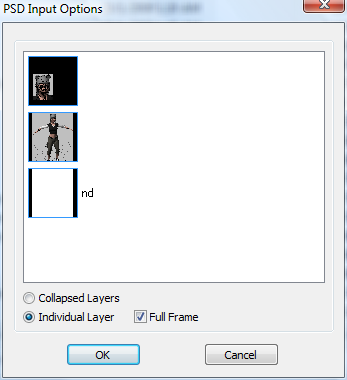PSD is the filename extension for graphics files native to Adobe ® Photoshop ® . This image format supports multiple layers of images superimposed to get the final image. Each layer can have any number of channels (R, G, B, Mask, and so on). It is a powerful file format because multiple layers can contribute to a variety of special effects.
Adobe provides many different modes of superimposing layers, including normal, darken, lighten, difference, multiply, screen, dissolve, hard light, hue, saturation, color, luminosity, overlay, and soft light.
You can use PSD files as bitmaps, viewport backgrounds, and so on. You can't render to a PSD file.
3ds Max supports the Photoshop format, and allows you to use image layers as bitmaps, as well as the entire composited graphic.
Limitations
- Bits Per Channel
-
Photoshop supports images with 1, 8, and 16 bits per channel (1-, 24-, and 48-bit RGB images, respectively). 3ds Max supports PSD images with 8 or 16 bits per channel. (In practice, there are very few images with 1 bit per channel.) While Photoshop can load images with 16 bits per channel, layers are always 8 bits per channel.
- Modes
-
3ds Max supports .psd files saved in the following modes:
- RGB
- Grayscale
3ds Max doesn't support the following Photoshop modes:
- Indexed Color
- Bitmap
- Duotone
- CMYK Color
- Lab Color
- Multichannel
- Non-Image Layers
-
Layers other than image layers (for example, text layers) are not supported. In Photoshop, you can “rasterize” a non-image layer to make it an image.
- Compositing Options
-
Compositing options between image layers, which require processing by Photoshop, are not supported.
Interface
When you open a PSD file as a bitmap, a dialog appears that lets you choose how to use the image.

Collapsed Layers displays the entire image.
- Collapsed Layers (The default.) Uses the entire composited image for displaying the bitmap. This composite must be generated when saving the PSD file (see the Photoshop help). Note: The composite image is used only for displaying the bitmap image; 3ds Max maintains all layers from the PSD file separately in memory. You can edit the individual layers and add new ones within 3ds Max with Viewport Canvas.
- Individual Layer Uses a single layer of the image. When you choose this, the dialog shows a list of the layers, with a thumbnail of each, and the layer names. Click a layer to choose it, then click OK.

Individual Layer displays list of layers to choose from.
Full Frame When on, uses the entire layer as the bitmap. When off, uses only that portion of the layer occupied by image data. Default=on.